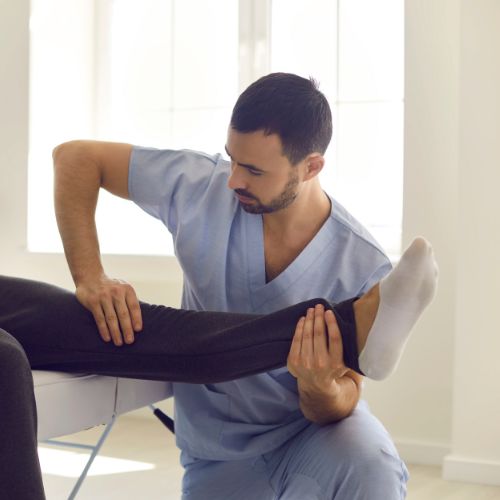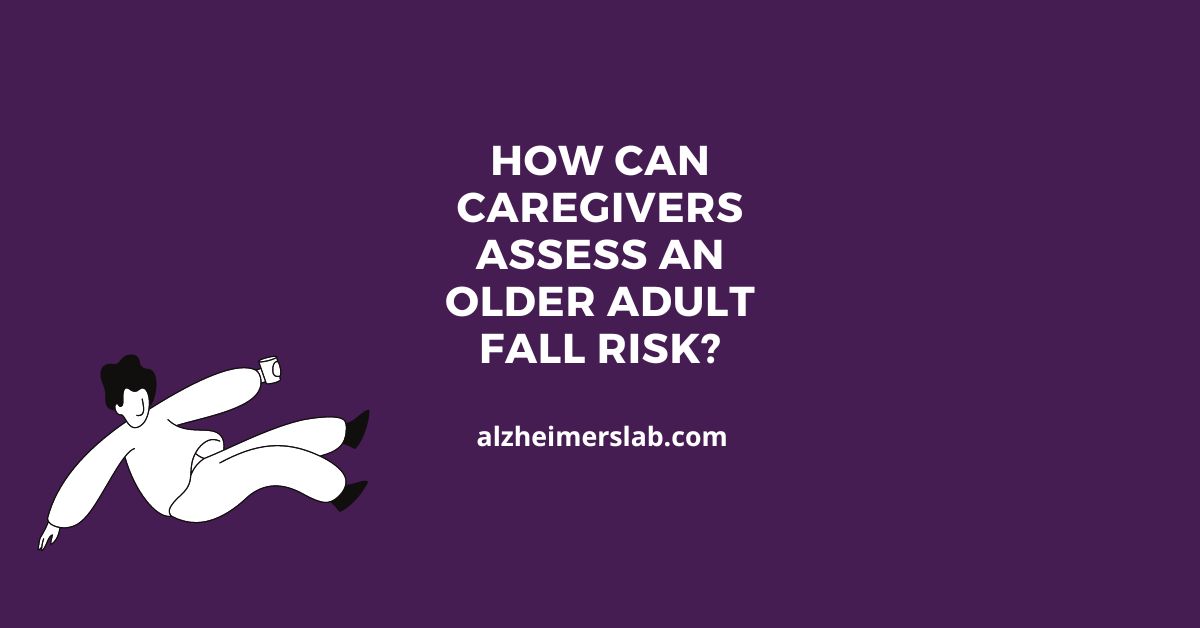How Can Caregivers Assess an Older Adult Fall Risk?
As our loved ones age, we naturally want to do everything in our power to keep them safe and healthy. One of the biggest risks older adults face is falling, which can result in serious injuries and even death. As a caregiver, it’s essential to assess the fall risk of the older adults in your care, so that you can take proactive steps to prevent falls from happening. Let’s take a closer look at how caregivers can assess an older adult’s fall risk.
Here’s an action plan for assessing fall risk in older adults:
1. Review the Older Adult’s Medical History and Medications
Review the older adult’s medical history and medications to identify any conditions or medications that may increase their fall risk.
2. Conduct a Physical Examination

Conduct a physical examination, including an assessment of balance, gait, and muscle strength.
3. Evaluate Vision and Hearing

Evaluate the older adult’s vision and hearing to identify any impairments that may increase their fall risk.
4. Assess Cognitive Function
Assess the older adult’s cognitive function to identify any impairments that may increase their fall risk.
5. Check for Environmental Hazards
Check the older adult’s homes and other environments they frequent for environmental hazards that may increase their fall risks, such as loose rugs or poor lighting.
6. Ask About Previous Falls
Ask the older adult if they have experienced any falls in the past, when they occurred, and what caused them.
7. Use a Fall Risk Assessment Tool
Use a fall risk assessment tool to help quantify the older adult’s fall risk. Some commonly used tools include the Timed Up and Go (TUG) test, the Berg Balance Scale, and the Hendrich II Fall Risk Model.
8. Discuss Findings with Healthcare Providers
Discuss your findings with the older adult’s healthcare providers, including their primary care physician and any specialists they may be seeing. Work together to develop a plan to address any identified risk factors and prevent falls from occurring.
9. Implement Preventive Measures
Implement preventive measures to reduce older adults’ fall risk. This may include:
- Encouraging regular exercise to improve balance and strength
- Modifying the home environment to minimize hazards
- Reviewing and adjusting medications that may increase fall risk
- Providing assistive devices, such as canes or walkers, as needed
10. Monitor and Reassess
Monitor the older adult’s fall risk over time and reassess as needed. Fall risk can change over time due to changes in health status, medications, or environmental factors. Regular reassessment can help ensure that preventive measures remain effective.
By following these steps, caregivers can develop a comprehensive action plan for assessing fall risk in older adults and taking proactive steps to prevent falls.
How to conduct a quick physical examination of an older adult?
As a caregiver, it’s important to know how to conduct a quick physical examination of an older adult. Here are some steps you can follow:
1. Start by introducing yourself and explaining why you need to perform the examination.
2. Ask the older adult how they are feeling and if they have any concerns about their health.
3. Check the older adult’s vital signs, including their blood pressure, heart rate, respiratory rate, and temperature. You can use a digital blood pressure monitor and a thermometer to take these measurements quickly and accurately.
4. Assess the older adult’s mobility by asking them to stand up and walk a few steps. Observe their gait, balance, and coordination.
5. Check the older adult’s muscle strength by asking them to squeeze your hand with each hand separately. You can also ask them to lift their legs one at a time while sitting down to check for any weakness.
6. Evaluate the older adult’s range of motion by asking them to move their arms and legs in different directions.
7. Observe the older adult’s skin for any signs of injury or irritation, such as bruises, cuts, or rashes.
8. Check the older adult’s eyes and ears for any signs of impairment, such as redness, discharge, or hearing loss.
9. Ask the older adult if they have any pain or discomfort in any specific areas of their body.
10. Finally, document your findings and share them with the older adult’s healthcare provider.
Remember, this quick physical examination is not a substitute for a full medical assessment by a healthcare professional. If you have any concerns about the older adult’s health or well-being, be sure to consult with their healthcare provider.
How to evaluate an older adult’s vision and hearing?
As a caregiver, it’s important to evaluate an older adult’s vision and hearing to ensure they can see and hear clearly and safely. Here are some steps you can follow:
1. Observe the older adult’s behavior. Look for any signs of vision or hearing impairment, such as squinting, holding reading material close to their face, turning up the volume on the TV, or asking others to repeat themselves.
2. Ask the older adult about any changes they have noticed in their vision or hearing, such as blurred vision or difficulty hearing certain sounds.
3. Use a vision screening tool, such as the Snellen chart, to assess the older adult’s visual acuity. This tool measures how well the older adult can see objects at a distance.
4. Use a hearing screening tool, such as the Whisper Test, to assess the older adult’s ability to hear sounds at a normal conversational level.
5. Encourage the older adult to have regular eye and ear exams with their healthcare provider. These exams can detect early signs of vision and hearing problems and help prevent further deterioration.
6. Make sure the older adult has adequate lighting in their home, especially in areas where they spend a lot of time, such as the kitchen and living room.
7. Ensure that the older adult’s glasses and hearing aids are properly fitted and in good working order.
8. Consider making environmental modifications to improve safety, such as adding handrails and non-slip mats in the bathroom and kitchen.
Remember, evaluating an older adult’s vision and hearing is an ongoing process, and it’s important to monitor their vision and hearing regularly and adjust their care plan as needed. By following these steps, caregivers can help ensure that older adults can see and hear clearly and safely.
How to assess an older adult’s cognitive function?
As a caregiver, assessing an older adult’s cognitive function is an important part of their overall care.
Here are some steps you can follow:
1. Start by observing the older adult’s behavior, such as their ability to carry out activities of daily living, communicate effectively, and interact with others. Look for any signs of confusion, forgetfulness, or disorientation.
2. Use a standardized cognitive screening tool, such as the Mini-Mental State Examination (MMSE), to assess the older adult’s cognitive function. This tool can help identify cognitive impairments and track changes over time.
3. Ask the older adult questions that test their memory, attention, language, and executive function. For example, you could ask them to repeat a series of numbers or words, name objects in a picture, or perform simple calculations.
4. Observe the older adult’s ability to follow instructions and carry out tasks, such as getting dressed or preparing a meal. Look for any signs of difficulty or confusion.
5. Consider the older adult’s medical history and any medications they are taking, as some medical conditions and medications can affect cognitive function.
6. Evaluate the older adult’s mood and emotional state, as depression and anxiety can also affect cognitive function.
7. Document your findings and share them with the older adult’s healthcare provider. If cognitive impairment is identified, the healthcare provider may recommend additional testing or refer the older adult to a specialist for further evaluation and treatment.
Remember, assessing cognitive function is an ongoing process, and it’s important to monitor the older adult’s cognitive function over time and adjust their care plan as needed. By following these steps, caregivers can help identify cognitive impairments early and take proactive steps to manage them.
What fall risk assessment tools can I use as a caregiver?
As a caregiver, there are several fall risk assessment tools you can use to identify an older adult’s risk of falling. Here are some commonly used tools:
1. Timed Up and Go (TUG): This tool measures the time it takes an older adult to stand up from a chair, walk a short distance, turn around, and sit back down again. A time of 12 seconds or more suggests an increased risk of falling.
2. Berg Balance Scale: This tool assesses an older adult’s ability to maintain balance while performing a series of tasks, such as standing on one foot and reaching forward. Scores range from 0 to 56, with a score of 45 or lower indicating an increased risk of falling.
3. Functional Reach Test: This tool measures the distance an older adult can reach forward without losing their balance. A distance of fewer than 10 inches suggests an increased risk of falling.
4. 4-Stage Balance Test: This tool assesses an older adult’s ability to maintain balance while standing on one foot with their eyes open and closed, and while standing on their toes and heels. The test is scored based on the amount of sway observed during each task.
5. Tinetti Assessment Tool: This tool assesses an older adult’s balance and gait by evaluating their ability to stand up from a chair, walk, turn, and sit back down again. Scores range from 0 to 28, with a score of 18 or lower indicating an increased risk of falling.
It’s important to note that these tools are not a substitute for a comprehensive fall risk assessment by a healthcare professional.
Conclusion
Assessing an older adult’s fall risk is an essential part of caregiving. By understanding the risk factors, observing their mobility, checking for medication side effects, assessing the home environment, and considering previous falls, and cognitive function, you can take proactive steps to prevent falls from occurring. Taking the time to assess fall risk and implementing appropriate interventions can help keep your loved one safe and independent for as long as possible.

